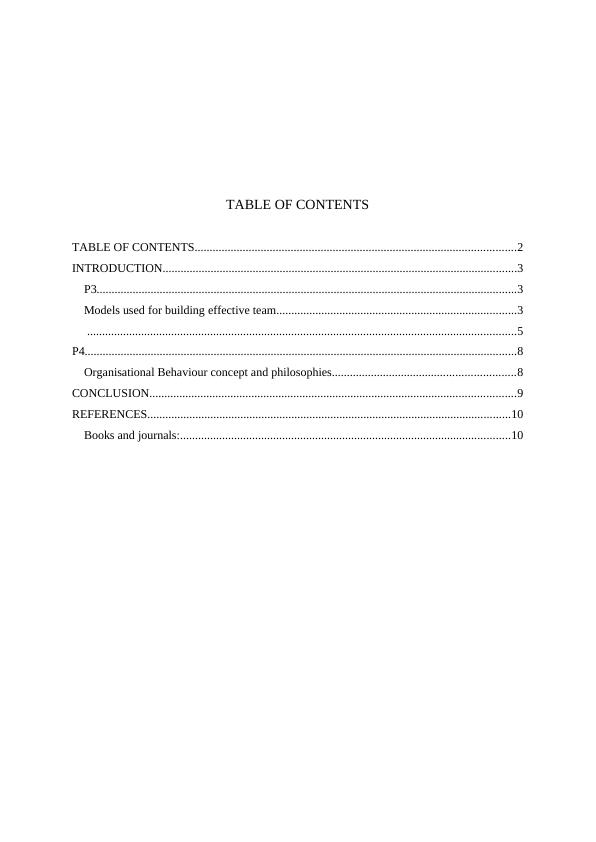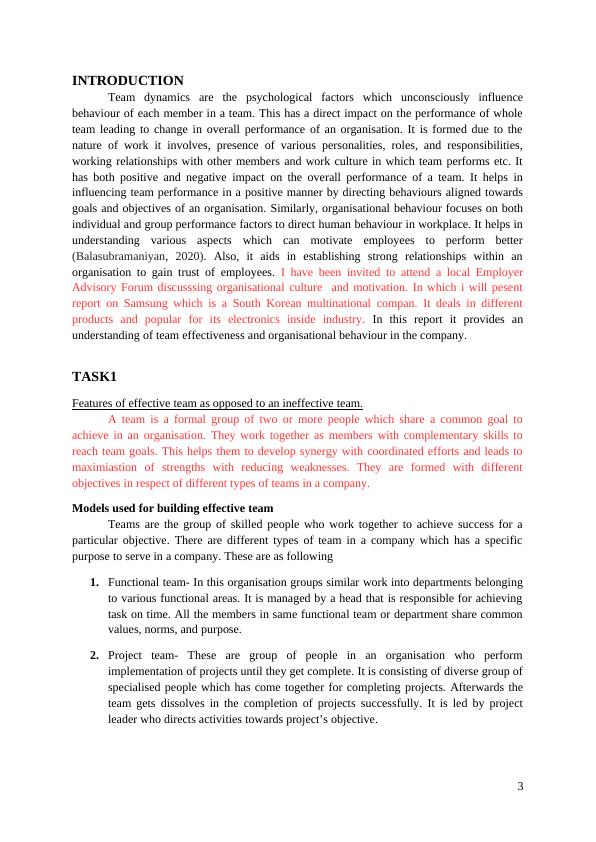Team Dynamics and Organisational Behaviours
12 Pages4163 Words47 Views
Added on 2023-01-03
About This Document
This document explores the impact of team dynamics and organisational behaviours on performance. It discusses the qualities of effective teams, models used for building effective teams, and the role of technology in team development. The document also provides insights into how Samsung utilizes these concepts to enhance team effectiveness.
Team Dynamics and Organisational Behaviours
Added on 2023-01-03
ShareRelated Documents
TEAM DYNAMICS AND
ORGANISATIONAL
BEHAVIOURS
1
ORGANISATIONAL
BEHAVIOURS
1

TABLE OF CONTENTS
TABLE OF CONTENTS...........................................................................................................2
INTRODUCTION......................................................................................................................3
P3............................................................................................................................................3
Models used for building effective team................................................................................3
...............................................................................................................................................5
P4................................................................................................................................................8
Organisational Behaviour concept and philosophies.............................................................8
CONCLUSION..........................................................................................................................9
REFERENCES.........................................................................................................................10
Books and journals:..............................................................................................................10
TABLE OF CONTENTS...........................................................................................................2
INTRODUCTION......................................................................................................................3
P3............................................................................................................................................3
Models used for building effective team................................................................................3
...............................................................................................................................................5
P4................................................................................................................................................8
Organisational Behaviour concept and philosophies.............................................................8
CONCLUSION..........................................................................................................................9
REFERENCES.........................................................................................................................10
Books and journals:..............................................................................................................10

INTRODUCTION
Team dynamics are the psychological factors which unconsciously influence
behaviour of each member in a team. This has a direct impact on the performance of whole
team leading to change in overall performance of an organisation. It is formed due to the
nature of work it involves, presence of various personalities, roles, and responsibilities,
working relationships with other members and work culture in which team performs etc. It
has both positive and negative impact on the overall performance of a team. It helps in
influencing team performance in a positive manner by directing behaviours aligned towards
goals and objectives of an organisation. Similarly, organisational behaviour focuses on both
individual and group performance factors to direct human behaviour in workplace. It helps in
understanding various aspects which can motivate employees to perform better
(Balasubramaniyan, 2020). Also, it aids in establishing strong relationships within an
organisation to gain trust of employees. I have been invited to attend a local Employer
Advisory Forum discusssing organisational culture and motivation. In which i will pesent
report on Samsung which is a South Korean multinational compan. It deals in different
products and popular for its electronics inside industry. In this report it provides an
understanding of team effectiveness and organisational behaviour in the company.
TASK1
Features of effective team as opposed to an ineffective team.
A team is a formal group of two or more people which share a common goal to
achieve in an organisation. They work together as members with complementary skills to
reach team goals. This helps them to develop synergy with coordinated efforts and leads to
maximiastion of strengths with reducing weaknesses. They are formed with different
objectives in respect of different types of teams in a company.
Models used for building effective team
Teams are the group of skilled people who work together to achieve success for a
particular objective. There are different types of team in a company which has a specific
purpose to serve in a company. These are as following
1. Functional team- In this organisation groups similar work into departments belonging
to various functional areas. It is managed by a head that is responsible for achieving
task on time. All the members in same functional team or department share common
values, norms, and purpose.
2. Project team- These are group of people in an organisation who perform
implementation of projects until they get complete. It is consisting of diverse group of
specialised people which has come together for completing projects. Afterwards the
team gets dissolves in the completion of projects successfully. It is led by project
leader who directs activities towards project’s objective.
3
Team dynamics are the psychological factors which unconsciously influence
behaviour of each member in a team. This has a direct impact on the performance of whole
team leading to change in overall performance of an organisation. It is formed due to the
nature of work it involves, presence of various personalities, roles, and responsibilities,
working relationships with other members and work culture in which team performs etc. It
has both positive and negative impact on the overall performance of a team. It helps in
influencing team performance in a positive manner by directing behaviours aligned towards
goals and objectives of an organisation. Similarly, organisational behaviour focuses on both
individual and group performance factors to direct human behaviour in workplace. It helps in
understanding various aspects which can motivate employees to perform better
(Balasubramaniyan, 2020). Also, it aids in establishing strong relationships within an
organisation to gain trust of employees. I have been invited to attend a local Employer
Advisory Forum discusssing organisational culture and motivation. In which i will pesent
report on Samsung which is a South Korean multinational compan. It deals in different
products and popular for its electronics inside industry. In this report it provides an
understanding of team effectiveness and organisational behaviour in the company.
TASK1
Features of effective team as opposed to an ineffective team.
A team is a formal group of two or more people which share a common goal to
achieve in an organisation. They work together as members with complementary skills to
reach team goals. This helps them to develop synergy with coordinated efforts and leads to
maximiastion of strengths with reducing weaknesses. They are formed with different
objectives in respect of different types of teams in a company.
Models used for building effective team
Teams are the group of skilled people who work together to achieve success for a
particular objective. There are different types of team in a company which has a specific
purpose to serve in a company. These are as following
1. Functional team- In this organisation groups similar work into departments belonging
to various functional areas. It is managed by a head that is responsible for achieving
task on time. All the members in same functional team or department share common
values, norms, and purpose.
2. Project team- These are group of people in an organisation who perform
implementation of projects until they get complete. It is consisting of diverse group of
specialised people which has come together for completing projects. Afterwards the
team gets dissolves in the completion of projects successfully. It is led by project
leader who directs activities towards project’s objective.
3

3. Task force team- These are most popular form of teams which perform emergency
task to resolve and deal with uncertainty. It involves experienced or expert people to
find resolution of an uncertain situation or problem.
4. Problem solving team- These are research and development team who is employed for
finding better solutions for their problems. It helps in improving processes by finding
innovative action plans or methods (Creasy and Carnes, 2017).
Difference between a group and team:
Groups are consisting of two or more people which come together for a common
purpose in a society. These are the social communities which help in resolving problems and
enhancing values in the society. Whereas teams are one of the parts of groups which shares
common goal to achieve and has an overall impact on the performance. Groups are made out
of informal interaction with concerned people whereas teams are made with formal
communication structure in company. Groups are formed with society welfare interest with
specific purpose whereas teams are formed for achieving shared goal with company interest.
Qualities of effective teams
Following are the qualities for an effective team:
1. Focuses on goals and results- If members of a team is more focused on team goals
then they will most probably able to reach goals effectively. For example, in samsung
fuctional teams are more focused on goals and outcomes which leads to better
understanding of goals. This help them to formulate clear plan and contribution of
each member to achieve goals effectively.
2. Diversity- It includes varied number of people which helps in innovating and finding
unique solutions. For example, samsung has diversity of people from different
cultures in their teams. This help them in bringing broad range of ideas and covering
required skills inside the team.
3. Supportive- When teams are supportive and assist each other this leads to more
productivity and cohesivness. For example, in samsung members of a team are
supportive and help each other. Organisation also offer support which leads to
employee involvement and helps in accessing required resources.
4. Effective communication- It is important in a team to communicate with each other
which leads to bringing cohesiveness and team spirit. For example, in samsung teams
are open and freely communicate with each other. This leads to building friendly
environment and completion of task efficiently.
Identify a quality: Each team member has an opportunity to contribute
task to resolve and deal with uncertainty. It involves experienced or expert people to
find resolution of an uncertain situation or problem.
4. Problem solving team- These are research and development team who is employed for
finding better solutions for their problems. It helps in improving processes by finding
innovative action plans or methods (Creasy and Carnes, 2017).
Difference between a group and team:
Groups are consisting of two or more people which come together for a common
purpose in a society. These are the social communities which help in resolving problems and
enhancing values in the society. Whereas teams are one of the parts of groups which shares
common goal to achieve and has an overall impact on the performance. Groups are made out
of informal interaction with concerned people whereas teams are made with formal
communication structure in company. Groups are formed with society welfare interest with
specific purpose whereas teams are formed for achieving shared goal with company interest.
Qualities of effective teams
Following are the qualities for an effective team:
1. Focuses on goals and results- If members of a team is more focused on team goals
then they will most probably able to reach goals effectively. For example, in samsung
fuctional teams are more focused on goals and outcomes which leads to better
understanding of goals. This help them to formulate clear plan and contribution of
each member to achieve goals effectively.
2. Diversity- It includes varied number of people which helps in innovating and finding
unique solutions. For example, samsung has diversity of people from different
cultures in their teams. This help them in bringing broad range of ideas and covering
required skills inside the team.
3. Supportive- When teams are supportive and assist each other this leads to more
productivity and cohesivness. For example, in samsung members of a team are
supportive and help each other. Organisation also offer support which leads to
employee involvement and helps in accessing required resources.
4. Effective communication- It is important in a team to communicate with each other
which leads to bringing cohesiveness and team spirit. For example, in samsung teams
are open and freely communicate with each other. This leads to building friendly
environment and completion of task efficiently.
Identify a quality: Each team member has an opportunity to contribute

End of preview
Want to access all the pages? Upload your documents or become a member.
Related Documents
Team Dynamics and Organisational Behaviourslg...
|15
|4548
|1
Team Working Assignment (Doc)lg...
|10
|2748
|43
Organisational Behaviour: Team Development, Theories, and Barrierslg...
|19
|891
|86
Organisation Behaviour: Cooperation, Team Dynamics, and Leadership Theorieslg...
|11
|792
|27
Knowledge Questions | Team and Group Dynamicslg...
|7
|1435
|21
(Doc) P3 Effective team as opposed to an ineffective teamlg...
|10
|2775
|135
